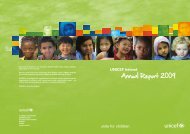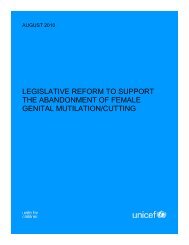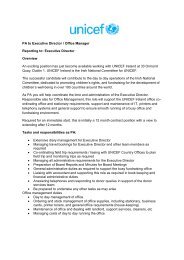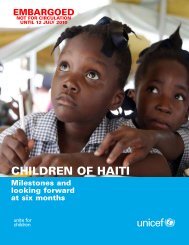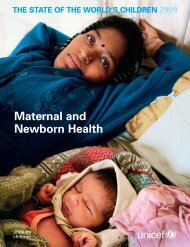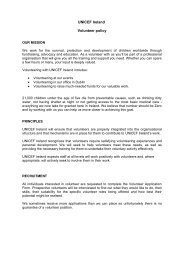Humanitarian Action for Children 2011 - Unicef
Humanitarian Action for Children 2011 - Unicef
Humanitarian Action for Children 2011 - Unicef
- No tags were found...
You also want an ePaper? Increase the reach of your titles
YUMPU automatically turns print PDFs into web optimized ePapers that Google loves.
In Madagascar, UNICEF supported a programmeto train and raise awareness amongvillage chiefs, school directors, health centreheads, community-based organizationsand mayors on water, sanitation and hygiene(WASH) principles and practices in emergencyresponse. Pre-emergency cooperation agreementshave been developed with the participatingorganizations to ensure a timely and rapidresponse in the event of a cyclone or flooding.Such ef<strong>for</strong>ts are an example of how UNICEF’scommitment to ensuring the participation ofaffected populations promotes collective actionand cohesion.UNICEF’s commitment to the rights ofthe most vulnerable compels us to workin ways that prioritize the restorationof self-reliance in emergencies.The revised CCCs also tighten the linkbetween humanitarian action and development.This stronger integration contributes to UNICEF’s institutional flexibility – the nimblenesswith which our programmes adjust to evolvingsituations. In addition, the sharpened focuson disaster risk reduction and local capacitydevelopment as explicit strategies contribute tocommunities’ own flexibility in the face of multipleshocks, throughout the broader cycle ofprevention, response and recovery. In Ethiopia,UNICEF has sup ported disaster risk reductionthrough a government-led, decentralized healthextension programme to provide essentialhealth and nutrition services. This programmehas had a significant impact in the communities:Results show an increase in nationaltreatment capacity of severe acute malnutritionfrom 135,000 cases per month in 2009 to200,000 cases per month in 2010. Through thetreatment of children suffering from malnutrition,those with severe acute malnutrition cannow be identified earlier and receive life-savingtreatment closer to home, thus helping reducechildren’s vulnerability.Likewise, understanding on-the-ground realitiesis essential <strong>for</strong> achieving the CCCs. Beingcontinuously present be<strong>for</strong>e, during, andafter an emergency, as UNICEF is, can ensurethat the situation of children and womenis monitored and that interventions areappropriately designed, supporting adaptivelearn ing through the sharing and applicationof new approaches and technologies. Incyclone-affected areas of Myanmar, UNICEFsupported local authorities in using disasterresistantstandards to construct health centresand child-friendly schools. UNICEF continuesto advocate <strong>for</strong> wider, gradual adoption ofthese standards across the country.Our humanitarian partnerships with governments,local and international non-governmentalorganizations (NGOs), communities, civilsociety and the private sector – and at nationalto community levels – allow UNICEF to leveragediverse approaches as a method <strong>for</strong> achievingbetter results <strong>for</strong> children in humanitarianaction, thus promoting diversity. For example,UNICEF worked with numerous stakeholdersin the conflict-affected town of Marka, nearMogadishu, in a public-private partnershipapproach to water management. Building onthe capacities of local actors, project implementationcontinued even when Marka was inaccessibleto international United Nations staff.UNICEF’s commitment to the rights of themost vulnerable compels us to work in waysthat prioritize the restoration of self-reliancein emergencies. For example, in the OccupiedPalestinian Territory, in conjunction with NGOsand other counterparts, UNICEF implementedchild protection and psychosocial services tostrengthen the coping mechanisms of morethan 70,000 children and 36,000 caregivers inGaza. Since the 2009 crisis, UNICEF continuesto couple psychosocial support with acommunity-based approach that is integratedwith child protection networks.The humanitarian systemand resilienceThe humanitarian community, to fulfil its roleand obligations in the face of escalating risk,also needs to be resilient. The response to massivedisasters in 2010, such as those in Haitiand Pakistan, as well as to other smaller-scaleemergencies, has demonstrated the dedicationand effectiveness of the humanitarian sys tem4 <strong>2011</strong> UNICEF <strong>Humanitarian</strong> <strong>Action</strong> FOR CHILDREN | www.unicef.org/hac<strong>2011</strong>




